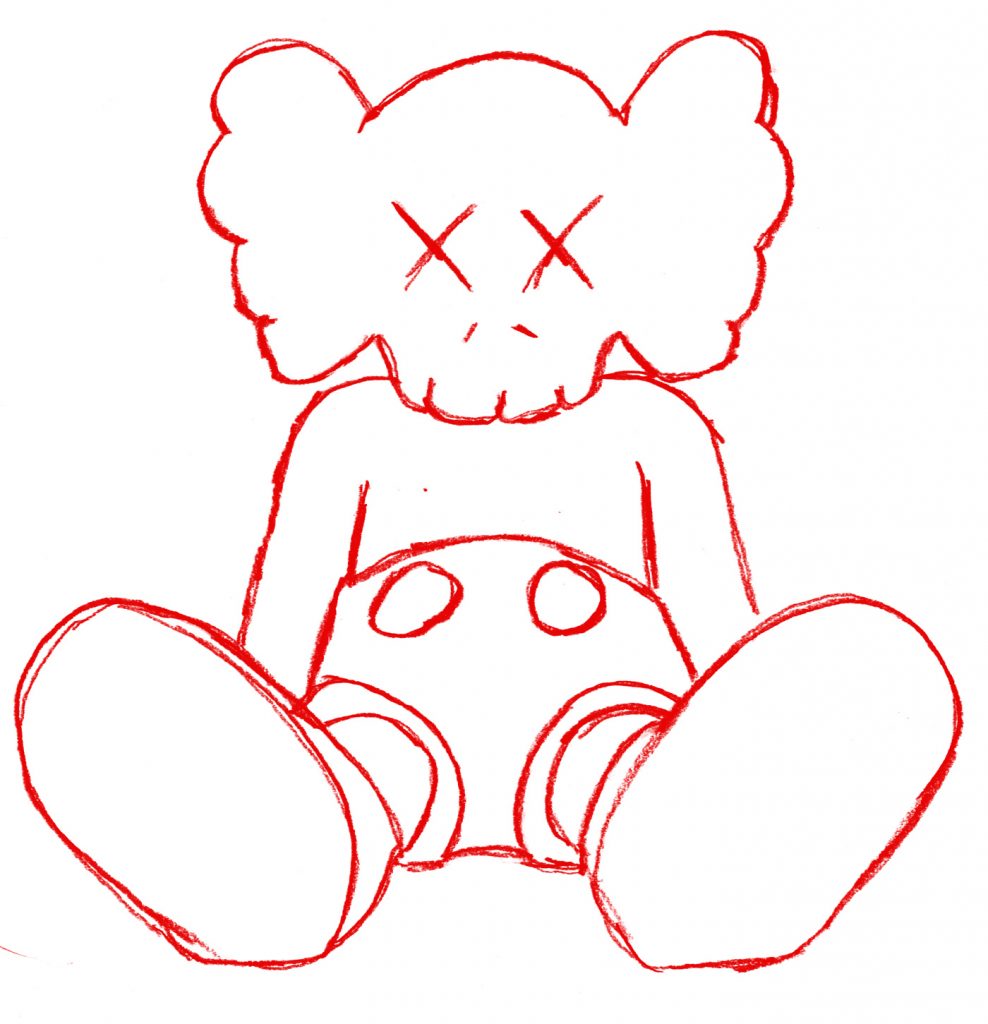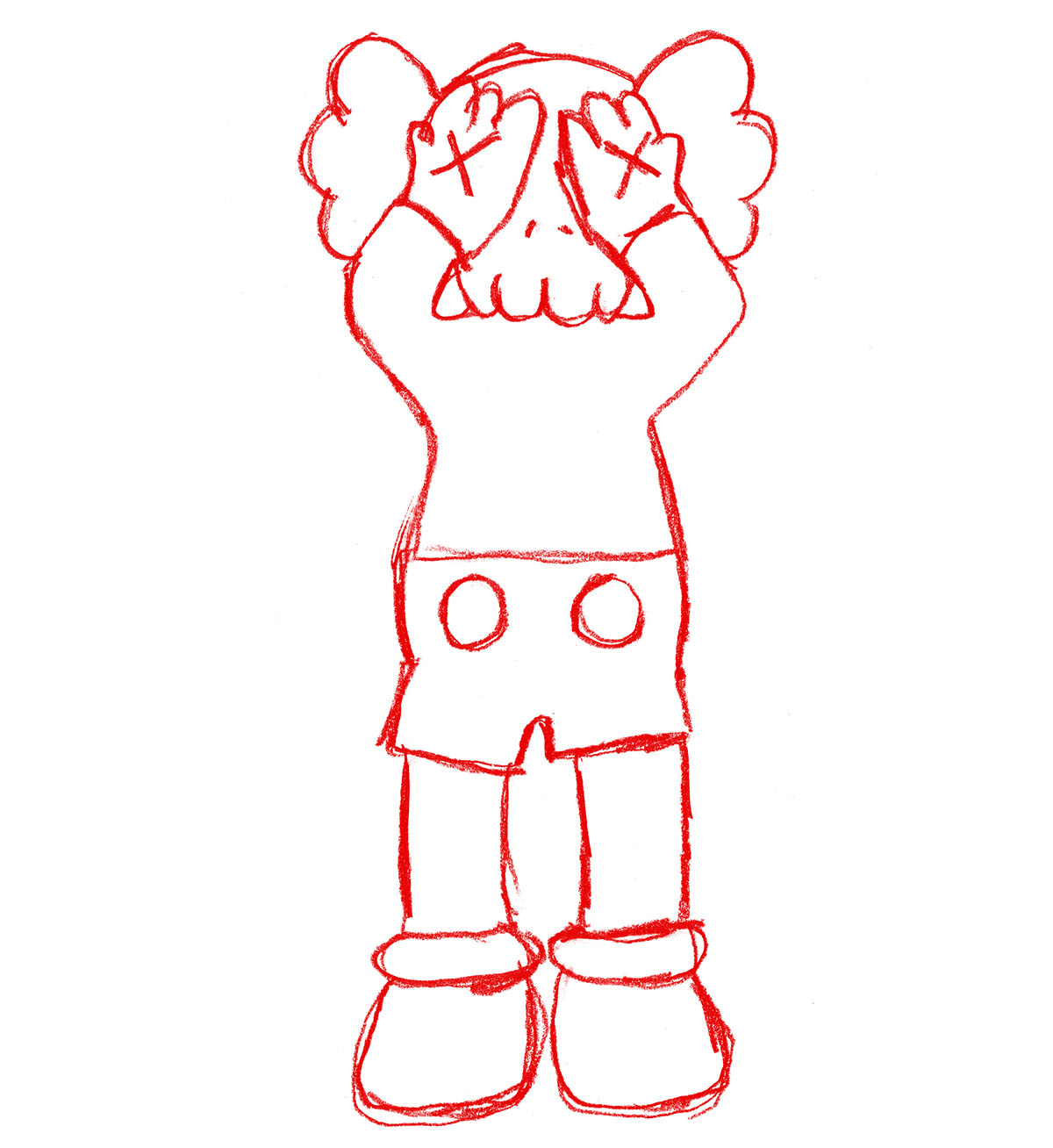A conversation with KAWS on the lives of his characters
Published in Nuda:Ego
Who are they? Characters like Bendy, Companion, Chomper, Chum and Accomplice seem to have personalities and emotional lives. The cartoonish-looking figures with X-ed out eyes are the most recognizable elements in the art of Brian Donnelly, better known as KAWS. Is Companion Brian’s alter ego? The figure was created 20 years ago and has passed through innumerable platforms and mediums. It has been in the Macy’s parade and seen as a massive inflatable on the Seokchon Lake. It’s been shot into outer space with CNN! It appeared as the award trophy at the MTV VMA gala, it has entered virtual reality and recently it’s been figuring in the world’s biggest video game Fortnite.
Donnelly was a teenager when he started tagging around his New Jersey neighborhood. In the early 90s, through skating, he found a community among the street artists. After his degree in illustration, he worked as an animator for Disney and his street art developed into new kinds of interventions. Donnelly would break into advertising cabinets and take down the posters in them to bring home. He then painted over them and put them back. The next morning the city would wake up with new artworks in the streets. His inspiration comes from many places. There are obvious traces of American pop art and the universe of comics. Visiting Japan during the late 90s, Donnelly was drawn to the otaku subculture with its typical collectibles, toys and characters. Right now KAWS seems to be the most visible artist in the world. The hype surrounding everything he touches is proof of his mass appeal. Pharrell Williams, Justin Bieber and DJ Khaled are among his collectors and he has collaborated with brands such as Comme de Garcons, Nike, and Uniqlo. In 2020, KAWS’ Companion was found face down, as an expression of the general mood in the pandemic year. It’s hard to say if the character has its own feelings or if it’s just a mirror of the inner life of the artist himself. As he recently puts it: Companion has become something like a sibling, and it’s taken on a life of its own. This character, in its carious iterations, has also become a way to communicate my thoughts and observations.
What is a self? Although constructed out of elements from the world of cartoons, such as Mickey Mouse, Spongebob and the Simpsons, some of KAWS characters seem to have deep feelings and empathy for each other. Maybe this is his achievement as an artist: His large figures out of wood or metal seem to have inner lives and emotions. They seem depressed, scared, angry or shy. Each one of them appears to be an ego.

Astrid Birnbaum: You don’t make your art under your own name, so I wonder – who is KAWS and how is he different from Brian?
KAWS: The name KAWS came about through doing graffiti and thinking of letters that have a good relationship with each other and a word that can just exist as a name without an existing definition. Over time I grew to like the anonymity it gave me and preferred it to my birth name when putting work out into the world. Today, I think KAWS and Brian Donnelly are pretty interchangeable but I do still like to keep my work under the name KAWS.
AB: I heard you were writing your tag all over New York City in the 90s. Can you tell me a bit of how you moved into the arts from graffiti and when you decided to become an artist?
KAWS: I don’t feel like I moved into the arts from graffiti, for me, it is one and the same thing. My entire life I’ve enjoyed making drawings and paintings and at some point that transitioned into doing graffiti and then painting over advertisements. At a certain point I started receiving opportunities to exhibit work but my mind has always been all fundamentally the same, I’ve looked at the practices equally. I think of creating objects and digital work in this same way – I just following my curiosities.
AB: Has the community around street art and skateboarding inspired you as an artist?
KAWS: I’ve always appreciated the people I’ve met through skating and graff. I think, in art in general, you have opportunities to meet or learn about people from many different backgrounds.
AB: You work a lot with references from popular culture, everything from TV-series to billboards and commercials. I feel like there are parallels between your practice and appropriation art, dada, pop and all kinds of genres that worked with known symbols and then redefined them or found a new context for them. What do you think art can attain when working with references we all recognize or have relationship with?
KAWS: Once an image is made it enters into a visual history. Some of these images are stronger than others and they stay in your mind. Often I find myself working with imagery that I can’t ignore. Making new work from an image I’ve seen helps me move on from it.
AB: There are some recurring characters in your work, like Companion, Bendy and Chum… Do these characters have life stories that you can tell us about? Do they somehow relate to each other? Can you tell us a bit about your process when developing them?
KAWS: I like to think of the characters that I created as actors. There isn’t a process to creating them –they just walk into a room one day and from that point on, I rather have a hard time getting rid of them. They do relate to each other, but just in the same way that siblings do.
I like to think of the characters that I created as actors
AB: Most of your characters seem friendly and emphatic, but the Companion sometimes appears to be sad, even depressed. Why is he that way? I read somewhere that the Companion might be a little bit of an alter ego to you, is that right?
KAWS: In a way, all the art one creates is an alter ego to oneself. I hope when someone views something I’ve made, they can find me within it and hopefully, they can find themselves in it as well. The emotions that might be perceived are just my thoughts and observations made into sculptures and paintings.
AB: When I look at your art I find it almost as you are developing a story, a series or comic.
KAWS: There is no story line and I’m not trying to develop a story with my art. I think there will be a story in the end but like life it’s nothing I can or would try to control. I like how non-human characters exist in society. They have a way of passing through most cultural and language barriers. This is what I find most interesting.


AB: On YouTube I have seen plenty of videos with titles like: “Take part of my entire Kaws collection” or “Unboxing my new Kaws figures” where people show objects like clothing, figures, dolls and sneakers. What’s your relation to collecting objects?
KAWS: Ha, I don’t think there is any explanation for why someone collects but I’m guilty of doing it too.
AB: Your art has been seen in many different contexts, from street culture to the biggest galleries and museums, and then there are all the collaborations with fashion brands like Dior and Marc Jacobs. Do you still consider yourself to be a street artist in spite of all institutional success?
KAWS: We have discussed graffiti and street art a lot in this interview but I should mention I haven’t done work on the street illegally in almost twenty years and I in no way try to be “undercover”. If anyone is looking at the work I’m making now and calling it street art or graffiti art I think they are completely lost, really not looking at all.
| Words | Astrid Birnbaum |
| Illustrations | NUDA |

